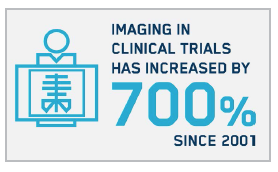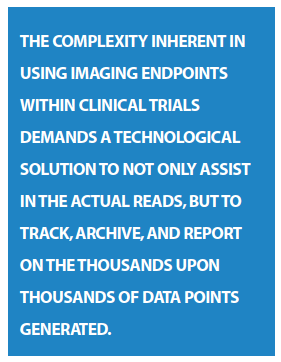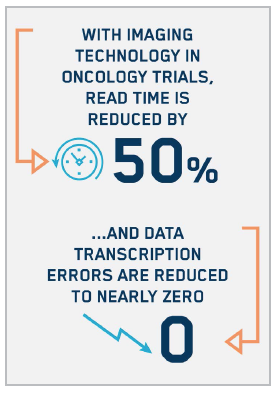 One of the great promises of technology is that it can simplify our lives. The need for it to do so is particularly strong in clinical research, where trials have been growing ever more complex. This is due, in part, to regulators’ increasing requests for the inclusion of imaging analysis when evaluating clinical trial data. In fact, the demand for imaging in clinical trials has increased by 700% since 20011. This trend extends beyond oncology trials to include any number of therapeutic areas such as the central nervous system, dermatology, and the musculoskeletal system. Imagine, for example, the challenges in managing the imaging data points for 475 patients in a Phase III oncology trial in which there are primary, secondary, and/or exploratory endpoint measures taken at six time points, with 200 images per time point. These 2,850 imaging sets, containing over 500,000 images, must be interpreted by qualified individuals using software in a way that is compliant with regulatory guidelines, and each measurement and observation must be documented and auditable.
One of the great promises of technology is that it can simplify our lives. The need for it to do so is particularly strong in clinical research, where trials have been growing ever more complex. This is due, in part, to regulators’ increasing requests for the inclusion of imaging analysis when evaluating clinical trial data. In fact, the demand for imaging in clinical trials has increased by 700% since 20011. This trend extends beyond oncology trials to include any number of therapeutic areas such as the central nervous system, dermatology, and the musculoskeletal system. Imagine, for example, the challenges in managing the imaging data points for 475 patients in a Phase III oncology trial in which there are primary, secondary, and/or exploratory endpoint measures taken at six time points, with 200 images per time point. These 2,850 imaging sets, containing over 500,000 images, must be interpreted by qualified individuals using software in a way that is compliant with regulatory guidelines, and each measurement and observation must be documented and auditable.
Unless sponsors make use of the proper software tools, the use of imaging in clinical trials can create exponential increases in workloads — and in opportunities for error and non-compliance. The right technology can, however, dramatically improve compliance, efficiency, and visibility in trials involving imaging. For instance, when technology-enabled reads are used in oncology trials, read time is cut in half and transcription errors are nearly eliminated2.
The Challenges: From Logistics to Data Integrity
The issues that pharmaceutical sponsors and contract research organizations (CROs) face in conducting trials with imaging endpoints range from mere inconvenience and inefficiencies to jeopardizing compliance and data integrity. These include:
 Workflow Compliance. Radiologists typically use the same imaging software in clinical trials that they use in their daily medical practice. The equipment is suited to the standard of care, but may not be compliant with the regulations governing clinical trials with respect to data integrity, auditing, and reproducibility. Consequently, trial leaders must compensate by surrounding the software with manual processes.
Workflow Compliance. Radiologists typically use the same imaging software in clinical trials that they use in their daily medical practice. The equipment is suited to the standard of care, but may not be compliant with the regulations governing clinical trials with respect to data integrity, auditing, and reproducibility. Consequently, trial leaders must compensate by surrounding the software with manual processes.
For example, radiologists routinely transfer images from their systems to centralized facilities (either via uploading them or burning them to a CD), making it difficult to track the chain of custody. To create a trail of evidence for the image requires manual logs and checks — a process that is not only time-consuming but introduces the risk of human error.
Visibility. When imaging data are managed manually or across multiple systems, it is very difficult to assess the status of imaging orders and to identify issues as they arise. A manual process is slow to provide insights, often taking weeks of analysis and potentially rendering data unusable.
Traceability. Many trials conducted today have little or no traceability for image-related measurements, such as a reader’s delineation of a tumor on a lung CT scan. This is because the imaging software that investigators use rarely provides for “a verifiable record of the imaging process,"3 as required by the U.S. Food and Drug Administration (FDA).
Maintaining the Blind. When images are “free floating"— that is when they are transferred between systems—there is a danger that people who should not have access can gain it, thereby unblinding information on the treatment assignment and potentially introducing bias into the study. This ultimately could disqualify a patient from continued participation in the study.
Protocol Deviations and Bias. Manually assessing images with arbitrary scoring can generate subjective and variable data that need to be cleaned of inconsistencies prior to submission — a laborious process. And, when image readers are left to their own devices, they may deviate from the study’s imaging charter and image evaluation protocol (IEP), allowing their unique and unconscious biases to creep into the analysis process.
Reconciliation. Often, images are burned to CDs and not reviewed for acceptability until the end of the trial when it is too late for issues to be resolved. Lost images and missing time points create reconciliation headaches at the end of trials. It is not uncommon for this step to tack an expensive additional two months onto the study timeline. Even worse, a late discovery of lost data can mean that biostatisticians have to reassess the data in light of a smaller cohort size just when the database should be locked.
Technology to the Rescue
 Today, advanced (yet proven) image analysis software can improve how imaging data are collected, evaluated, and submitted in a way that improves compliance, efficiency, and visibility.
Today, advanced (yet proven) image analysis software can improve how imaging data are collected, evaluated, and submitted in a way that improves compliance, efficiency, and visibility.
Such software is cloud-based, so there’s no need to invest in IT infrastructure. Investigative site users as well as those in sponsor companies and CROs need only have Internet access and logon credentials to use the system.
Supporting Compliance. The FDA’s guidance on imaging specifies, “In addition to images themselves, the image interpretations (case report forms or assessment tabulations) represent source data and should be retained for potential inspection and auditing."3
When a single, comprehensive system is used to upload, archive, analyze, and then report on images, imaging data are controlled, managed, and tracked throughout the study lifecycle. They never leave the system and are never reformatted. In this way, the software maintains a complete chain of custody for all images, and the sponsor never loses control of them.
The best-in-class systems track and time stamp every image-related activity, creating an audit trail that can be monitored and recalled at any point. And, access to images within the system is controlled via permissions to maintain the blind.
Increasing Efficiency. Because the images are never transferred outside of the system, there is never a need to manually inspect image transfers to compare what was sent to what was received. This is a significant administrative time-saver. And, as image observations and measurements are completed, the software captures each read, eliminating the need to transfer information into the electronic case report form (eCRF), which creates the potential for human error.
The software can be configured to support the workflow outlined in the protocol to ensure that the right people see the right images at the right time. Work progresses in a timely manner as images readers are prompted by the software when exams are ready to be read. Plus, edit checking can be integrated into the workflow at the earliest possible point to ensure that the data are correct. This minimizes the need to resolve errors months down the road, risking invalidating a data point. It is possible, for example, to build business rules into the software to prevent readers from accidentally entering a data point that doesn’t make sense. This saves time in cleaning the data — so much so that data issues at study close are significantly reduced. Metrics are automatically recorded, and all data and images are automatically archived.
The image management system also supports the actual read, pre-assessing images for the reader to then confirm. This computer-assisted analysis saves the reader time (as well as ensures consistency in reads as the same image will always result in the same measurement).
Improving Visibility. Imaging progress in a trial is asynchronous to the treatment regimen, and so must be monitored in its own right.
 Today’s image analysis software allows imaging status to be examined in real time, at the site or patient level. Such oversight enables study managers to identify sites that are having issues getting images scheduled, for instance, or to see which readers are performing their tasks on time, or to spot missing data points. Site managers, too, can have visibility into the status of a particular image. And, similarly, staff can confirm that billed activities related to trial imaging have, indeed, been performed.
Today’s image analysis software allows imaging status to be examined in real time, at the site or patient level. Such oversight enables study managers to identify sites that are having issues getting images scheduled, for instance, or to see which readers are performing their tasks on time, or to spot missing data points. Site managers, too, can have visibility into the status of a particular image. And, similarly, staff can confirm that billed activities related to trial imaging have, indeed, been performed.
In Conclusion
The complexity inherent in using imaging endpoints within clinical trials demands a technological solution to not only assist in the actual reads, but to track, archive, and report on the thousands upon thousands of data points generated. The most optimal, regulatory-compliant solutions are self-contained systems that integrate all image related activities, extending from the initial image upload to image reporting on the eCRF. Systems designed to manage the entire lifecycle of imaging will help sponsors protect data integrity, meet regulatory expectations and improve trial efficiency.
Editor’s Notes:
1 https://brackendata.com/blog-posts/medical-imaging-clinical-trials-growth-rate
2 http://ascopubs.org/doi/pdf/10.1200/CCI.17.
00026
3 “Clinical Trial Imaging Endpoints Process Standards: Guidance for Industry," FDA, March 2015.
ERT is a global data and technology company that minimizes uncertainty and risk in clinical trials so that its customers can move ahead with confidence. With nearly 50 years of clinical and therapeutic experience, ERT balances knowledge of what works with a vision for what’s next, so it can adapt without compromising standards.
For more information, visit ert.com.

















